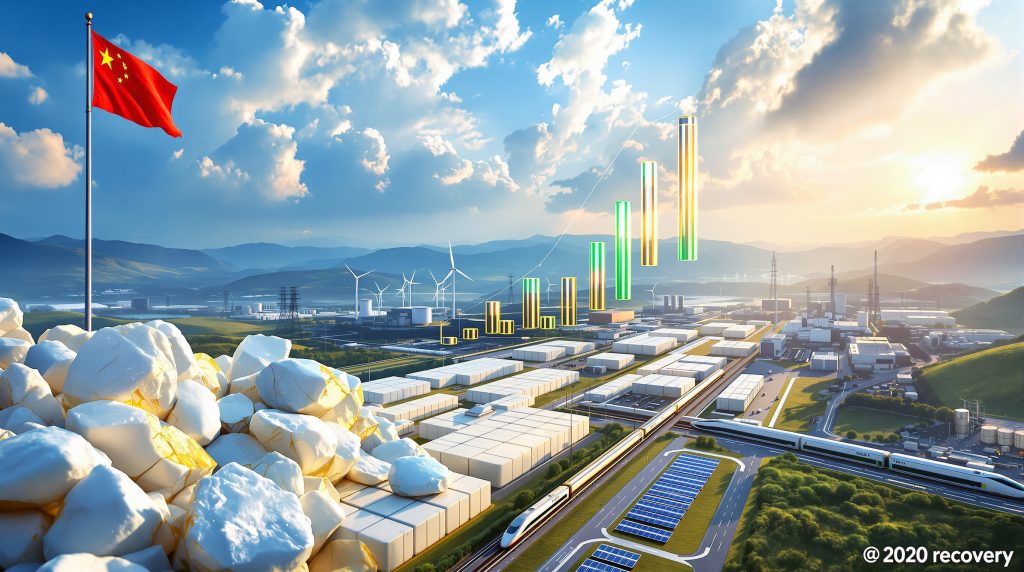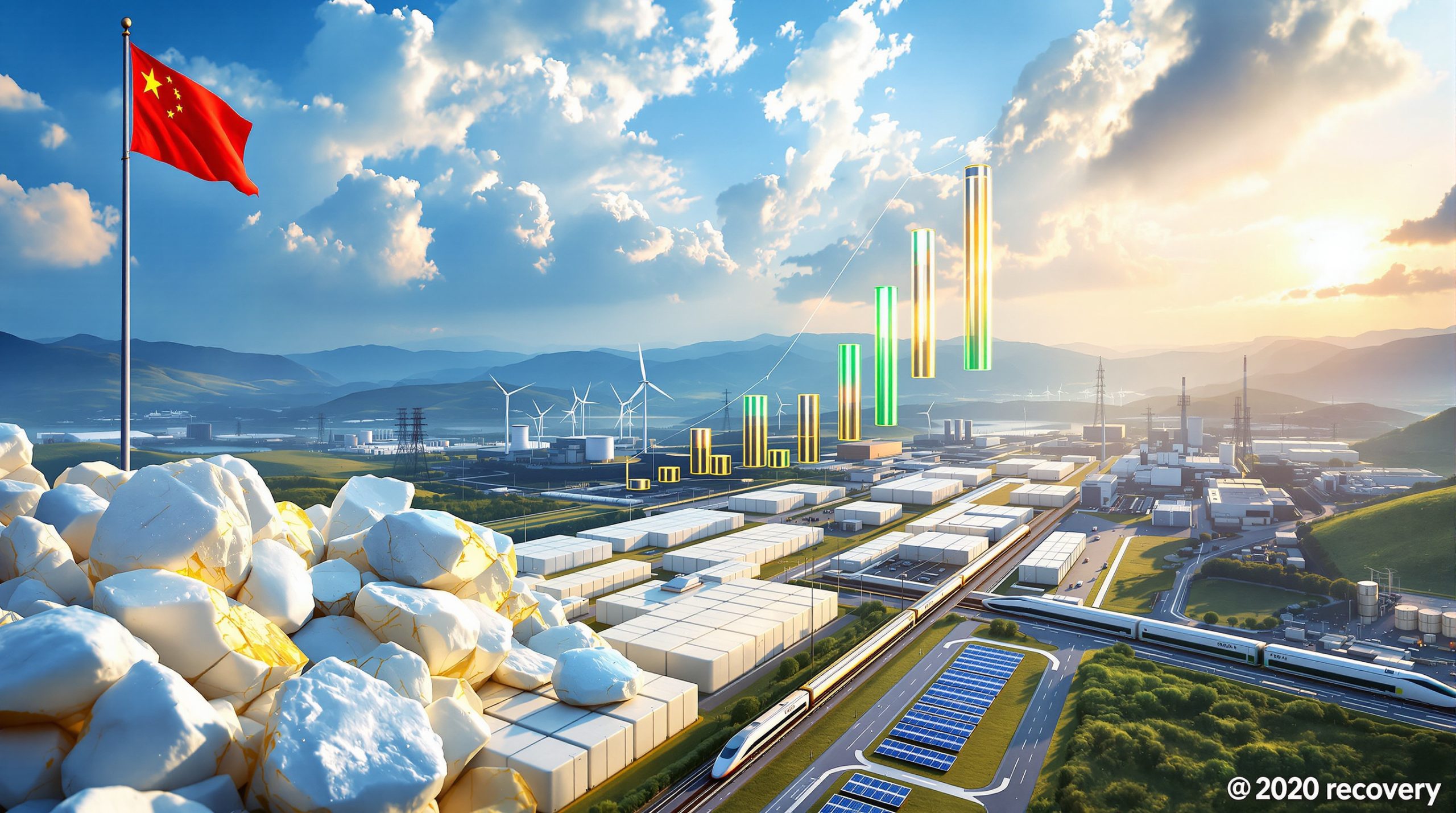What Drives Lithium Pricing in China's Energy Storage Revolution?
China's lithium market has experienced remarkable volatility throughout 2025, with lithium carbonate prices currently hovering around 79,000-82,000 CNY per tonne. This represents a significant recovery from earlier lows, though prices remain approximately 85% below their 2022 peaks of around 500,000 CNY per tonne. The recovery reflects fundamental shifts in market dynamics, driven primarily by China's aggressive energy storage expansion policies and evolving supply-demand balances.
The Guangzhou Futures Exchange's most-active lithium carbonate contract has posted five consecutive sessions of gains, signalling renewed market confidence. This momentum reflects broader structural changes in how lithium prices China energy storage applications are consumed globally, with energy storage emerging as a critical demand driver alongside traditional electric vehicle battery production.
Policy Framework Reshaping Market Dynamics
China's government unveiled comprehensive measures in September 2025 targeting a more than doubling of energy storage system capacity to 180 gigawatts by 2027. These policy initiatives include sophisticated compensation mechanisms designed to ensure adequate storage deployment matches peak electricity demand requirements across the national grid.
The strategic framework recognises energy storage as one of three pillars in China's industrial growth strategy, alongside solar panels and electric vehicles. This policy support creates predictable demand patterns that differ significantly from consumer-driven electric vehicle adoption cycles, providing greater market stability for lithium pricing.
Key Policy Elements:
- Mandatory storage-to-generation ratios for renewable energy projects
- Financial incentives for grid-scale battery installations
- Regulatory requirements for peak demand management
- Investment facilitation mechanisms for energy storage infrastructure
Market Recovery Indicators and Momentum
Recent performance metrics demonstrate the strength of lithium's price recovery in Chinese markets. Spot market prices have reached two-month highs, supported by improving fundamentals across multiple market segments. Furthermore, insights from Argentine lithium brine insights show similar trends emerging in global markets.
Current Market Performance:
| Metric | Current Status | Market Context |
|---|---|---|
| Lithium Carbonate Price | 79,000-82,000 CNY/tonne | 65% recovery from 2025 lows |
| Futures Performance | Five consecutive gains | Strongest momentum since 2022 |
| Port Inventory Levels | Declining trend | Supply tightening evident |
| Seasonal Demand | Entering strong period | Historical pattern supporting prices |
The convergence of these indicators suggests a more sustainable recovery compared to previous price volatility cycles driven purely by speculation or short-term supply disruptions.
How Is Energy Storage Demand Transforming China's Lithium Landscape?
Energy storage systems represent the fastest-growing segment of lithium consumption globally, with expansion rates in the mid-50% range annually compared to electric vehicle battery demand growth of approximately mid-20% per year. This dramatic difference in growth trajectories fundamentally alters long-term demand projections for lithium carbonate and hydroxide products.
The transformation reflects China's urgent need to integrate massive renewable energy capacity whilst maintaining grid stability. Unlike consumer electric vehicle adoption, which can fluctuate with economic conditions and policy changes, grid-scale energy storage deployment follows infrastructure planning cycles that provide greater demand visibility.
Grid Stabilisation Requirements Driving Consumption
China's renewable energy integration challenges create compelling technical requirements for battery storage deployment. Wind and solar power generation often produces electricity when demand is lowest, necessitating storage systems that can capture excess generation and release it during peak consumption periods.
This infrastructure requirement operates independently of consumer preferences or economic cycles affecting electric vehicle sales. Grid operators must deploy sufficient storage capacity to maintain system reliability, creating relatively predictable lithium demand patterns over multi-year planning horizons. In addition, Australian lithium policy innovations are influencing global approaches to strategic resource management.
Technical Requirements Driving Demand:
- Frequency regulation services for grid stability
- Peak shaving to manage daily demand cycles
- Renewable energy integration support
- Emergency backup power capabilities
Industrial Battery Production Scaling
China controls approximately 85% of global lithium battery production capacity, with manufacturing lines increasingly optimised for energy storage applications rather than electric vehicle batteries. Current energy storage cell prices range from 0.295-0.365 RMB per Wh, reflecting economies of scale achieved through dedicated production facilities.
The sector's growth trajectory has prompted major international players to redirect manufacturing capacity toward energy storage applications, with Samsung SDI converting some electric vehicle battery production lines to boost energy storage system output in the United States.
This production shift reflects longer-term industry recognition that energy storage markets may offer more stable demand patterns and profit margins compared to highly competitive electric vehicle battery segments. Moreover, developments in battery-grade lithium refinery projects are expanding global processing capacity.
What Supply-Side Factors Are Supporting Higher Lithium Prices?
Supply constraints have emerged as critical price support mechanisms throughout 2025, with regulatory oversight creating production uncertainties across China's key lithium mining and processing regions. These regulatory interventions have effectively addressed oversupply concerns that pressured lithium prices China energy storage markets during 2023 and early 2024.
The Chinese government's capacity control policies reflect broader strategic objectives around resource management and environmental compliance, creating a more controlled supply environment that supports price stability.
Regulatory Control Impact on Production
The Yichun lithium processing hub faces ongoing permit renewal challenges, with major operations including facilities operated by Contemporary Amperex Technology Co. experiencing production halts since August 2025. These regulatory interventions demonstrate government willingness to prioritise environmental compliance over maximum production volumes.
Regulatory Impact Assessment:
- Production capacity subject to government approval processes
- Environmental compliance requirements creating operational delays
- Permit renewal uncertainties affecting production planning
- Strategic resource management policies influencing supply volumes
Seasonal Demand Patterns and Inventory Dynamics
Market timing factors increasingly favour higher lithium prices as China enters traditionally strong demand periods. Port inventory levels for lithium raw materials have begun declining, indicating tightening supply-demand balances across key trading hubs.
Supply Tightening Indicators:
| Factor | Current Trend | Price Impact |
|---|---|---|
| Port Inventories | Declining | Supportive |
| Seasonal Demand | Strengthening | Bullish |
| Production Permits | Uncertain | Constraining supply |
| Import Dependence | High | Price volatility risk |
These dynamics create a more favourable environment for sustained price appreciation compared to periods when excess inventory overhang suppressed market pricing.
Which Global Trends Are Reinforcing China's Lithium Market Strength?
International energy storage adoption provides crucial additional demand support beyond domestic Chinese requirements, creating a more robust foundation for lithium market recovery. BloombergNEF projections indicate record-setting energy storage additions annually through 2035, with China and the United States maintaining dominant market positions.
This global expansion validates China's strategic focus on controlling battery supply chain components, as international demand growth supports domestic pricing even during periods of reduced local consumption. Consequently, global lithium market investment patterns are shifting toward Asia-Pacific regions.
Worldwide Energy Storage Deployment
Global energy storage deployment follows similar patterns to China's domestic expansion, driven by renewable energy integration requirements and grid modernisation initiatives. Major economies are implementing policies requiring energy storage deployment alongside renewable energy projects, creating sustained international demand for Chinese battery production.
International Market Drivers:
- European Union renewable energy mandates requiring storage components
- United States Inflation Reduction Act incentives for battery storage
- Developing nation grid modernisation projects
- Corporate renewable energy procurement requiring storage solutions
Artificial Intelligence Infrastructure Requirements
Data centre proliferation supporting artificial intelligence development creates unprecedented electricity demand patterns that traditional power generation cannot efficiently serve. AI processing requires consistent, high-quality power supply, necessitating grid stabilisation through battery storage systems integrated with data centre operations.
This technological shift adds another demand layer supporting lithium consumption growth, as data centre operators invest in on-site energy storage to ensure operational reliability and manage electricity costs during peak pricing periods. However, projects like the Thacker Pass lithium mine face environmental and regulatory challenges that could affect supply timelines.
How Do Current Prices Compare to Historical Patterns?
Despite recent recovery gains, lithium prices China energy storage markets remain substantially below previous peaks, suggesting potential for further appreciation as market fundamentals continue strengthening. Current pricing levels around 80,000 CNY per tonne compare to historical peaks near 500,000 CNY per tonne during 2022 supply shortage periods.
This significant gap indicates the market may have overcorrected from previous oversupply concerns, particularly given the emergence of energy storage demand as a more stable consumption base than purely electric vehicle-dependent scenarios.
Price Recovery Timeline and Trajectory
Historical Price Context:
| Period | Price Level (CNY/tonne) | Primary Market Driver |
|---|---|---|
| 2022 Peak | ~500,000 | Supply shortage crisis |
| Early 2024 | ~50,000 | Oversupply correction |
| Current 2025 | 79,000-82,000 | Energy storage demand recovery |
| Analyst Projections | 100,000+ | Balanced market conditions |
The recovery trajectory suggests gradual price appreciation rather than speculative bubbles, reflecting more sustainable demand patterns from energy storage applications compared to previous cycles driven primarily by electric vehicle battery speculation. For instance, according to China's lithium prices climb, the recovery demonstrates solid underlying demand fundamentals.
Valuation Metrics and Investment Implications
Current valuation metrics indicate lithium markets have transitioned from oversupply conditions toward more balanced supply-demand fundamentals. Energy storage demand provides greater consumption predictability than electric vehicle markets, which remain subject to consumer adoption uncertainties and economic cycle variations.
Investment Consideration Factors:
- Government policy support reducing demand uncertainty
- Infrastructure deployment timelines providing visibility
- Supply constraints supporting price stability
- Diversified demand sources reducing concentration risk
What Are the Key Risks and Opportunities in China's Lithium Market?
Market participants must navigate complex regulatory environments whilst capitalising on structural demand growth from China's energy storage expansion. Government capacity control policies create both supply constraints and operational uncertainties for lithium producers and processors.
The regulatory framework reflects broader Chinese strategic objectives around resource security and environmental protection, requiring market participants to adapt business models for greater government oversight and compliance requirements.
Supply Chain Vulnerability Assessment
Primary Risk Categories:
- Permit renewal uncertainties affecting production planning and capacity utilisation
- Environmental compliance costs increasing operational expenses and regulatory complexity
- Government capacity controls limiting production flexibility during high-demand periods
- Geopolitical considerations affecting international trade and supply chain security
These risk factors require sophisticated risk management approaches and diversified supply strategies for companies exposed to Chinese lithium markets.
Demand Growth Sustainability Analysis
Energy storage demand appears more sustainable than previous lithium consumption cycles, offering greater visibility for long-term planning and investment decisions. Government policy support provides additional certainty compared to market-driven demand cycles that characterised earlier lithium prices China energy storage volatility.
Sustainability Indicators:
- Infrastructure planning cycles extending 5-10 years
- Government mandates requiring storage deployment
- Technical grid requirements independent of economic cycles
- International policy alignment supporting global demand
How Should Investors Approach China's Lithium Price Recovery?
The convergence of policy support, supply constraints, and diversified demand sources creates potentially favourable conditions for lithium market participation, though significant volatility risks remain inherent in commodity markets. Current price levels may represent attractive entry opportunities for investors with medium to long-term investment horizons.
Investment strategy considerations must account for regulatory uncertainties and the Chinese government's demonstrated willingness to intervene in commodity markets when policy objectives require supply or price management. Furthermore, insights from lithium price forecasts suggest continued upward pressure on pricing.
Strategic Positioning Considerations
Primary Investment Themes:
- Energy storage infrastructure buildout supported by government mandates and grid modernisation requirements
- Battery technology advancement improving energy density and cost competitiveness for storage applications
- Supply chain security initiatives favouring vertically integrated companies with diverse geographic exposure
- Renewable energy integration creating sustained demand for grid-scale storage solutions
Market Timing and Entry Point Analysis
Current market conditions suggest lithium prices have stabilised above cyclical lows whilst remaining significantly below historical peaks, potentially offering favourable risk-reward profiles for strategic investors. Energy storage demand growth provides more predictable consumption patterns compared to previous cycles dependent primarily on electric vehicle adoption speculation.
Timing Considerations:
- Seasonal demand strengthening supporting near-term price stability
- Policy implementation timelines providing multi-year demand visibility
- Supply constraints limiting downside price risk
- International market expansion supporting sustained demand growth
Investment Disclaimer: Commodity markets involve significant risks including price volatility, regulatory changes, and geopolitical factors. Past performance does not guarantee future results. Investors should conduct thorough due diligence and consider professional advice before making investment decisions in lithium markets or related securities.
The lithium market's evolution from purely electric vehicle-driven demand toward diversified energy storage applications represents a fundamental shift that may support more sustainable pricing over longer time horizons, though investors must remain prepared for continued volatility inherent in commodity markets.
Ready to Capitalise on China's Lithium Market Recovery?
Discovery Alert's proprietary Discovery IQ model delivers real-time alerts on significant ASX mineral discoveries, instantly empowering subscribers to identify actionable opportunities in lithium and energy storage sectors ahead of the broader market. Begin your 30-day free trial today and position yourself to capture the next major discovery as China's energy storage revolution continues driving commodity demand.




